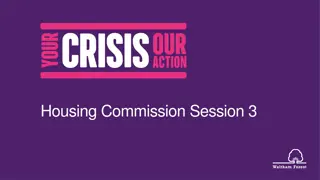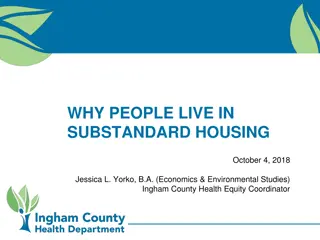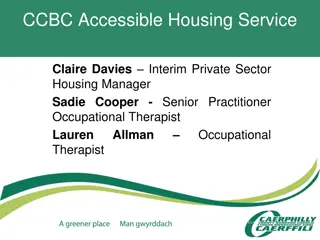Addressing Housing-Related Health Concerns in Child Renters
This presentation at the Family Medicine Forum in Montreal highlights the approach to addressing mould and housing-related health problems, focusing on a case of a child living in rental housing with allergic symptoms due to multiple moulds. Experts discuss strategies and initiatives to promote healthy housing environments for children. Financial sponsor disclosures and presenter information are also provided.
Download Presentation

Please find below an Image/Link to download the presentation.
The content on the website is provided AS IS for your information and personal use only. It may not be sold, licensed, or shared on other websites without obtaining consent from the author.If you encounter any issues during the download, it is possible that the publisher has removed the file from their server.
You are allowed to download the files provided on this website for personal or commercial use, subject to the condition that they are used lawfully. All files are the property of their respective owners.
The content on the website is provided AS IS for your information and personal use only. It may not be sold, licensed, or shared on other websites without obtaining consent from the author.
E N D
Presentation Transcript
Land Acknowledgement Traditional territory of the Kanien keh :ka, a place which has long served as a site of meeting and exchange amongst many First Nations including the Kanien keh :ka of the Haudenosaunee Confederacy, Huron/Wendat, Abenaki, and Anishinaabeg. The Kanien keh :ka are the traditional custodians of the lands and waters on which we meet during the conference. Our gratitude.
Approach to Mould and Housing-Related Health Problems Family Medicine Forum Montreal, November 9, 2023 Erica Phipps, MPH, PhD Executive Director, Canadian Partnership for Children s Health and Environment (CPCHE) Director, RentSafe Donald Cole, MD, DOHS, MSc, FRCP(C) Emeritus Professor, Dala Lana School of Public Health Primary Care Locum (Grey-Bruce) Geri Blinick, MA Project Manager, RentSafe CPCHE Marg Sanborn, MD, FCFP Adjunct Professor, McMaster University Primary care locum
Disclosure of Financial Sponsors/Support Presenter: Erica Phipps RentSafe/CPCHE: Catherine Donnelly Foundation Raffi Foundation for Child Honouring Postdoctoral Fellowship, University of Ottawa CIHR grant - Prenatal Environmental Health Education (PEHE) Collaboration Health Canada contract - Maternal-Infant Research on Environmental Chemicals (MIREC) Member, Canadian Committee on Indoor Air Quality No patents or other financial relationships Work referenced in this presentation received financial support, in the form of grants for projects and outreach, from the Dragonfly Foundation, Catherine Donnelly Foundation and Raffi Foundation for Child Honouring. The RentSafe initiative also benefits from in-kind support from RentSafe and CPCHE partners Potential for conflict(s) of interest: None
Presenter Disclosure - Financial Sponsors Presenter : Donald C Cole Public e-consult and clinical consult provider in Ontario Senior Advisor to Global Action For Fungal Infections (GAFFI) https://gaffi.org/who/senior-advisors/#biog4 Contracted MD with Occupational Health Clinic for Ontario Workers Receipt of honoraria from Workplace Safety and Insurance Board (WSIB) of Ontario as member of the Scientific Advisory Table on Occupational Disease Co-investigator on publicly funded grants, including on fungal infections. No patents or other financial relationships
Case 1 Child in rental housing with allergic sx multiple moulds in various locations throughout the house: Mushroom-like growth under kitchen sink child s bedroom closet adjacent to unvented bathroom - black mould, front hall closet - children s backpacks mouldy youngest child developed runny nose and generally ill sx resolved once family moved
Case 2 Senior living in co-op apartment in seniors complex chronic condensation around A/C ducts; mould eventually became visible on ceiling initial inquiry led to superficial clean-up follow-up revealed extensive mould in A/C system and surrounding areas multiple units affected Sx included chronic cough and congestion, fatigue & brain fog
Your experience Do these cases resonate with ones you have seen in your practice? Who among you have: Had patients come in with symptoms linkable to mould? Did you or the patient make the link to mould? Been frustrated on how to resolve the patient s health concern? Been successful in spurring mould clean up and resolution of symptoms? Made referrals to other service providers in the community?
Learning Objectives We hope that by the end of this session, you will be able to: 1. Recognize potential housing-related mould exposure and associated symptom clusters affecting patients 2. Assess patients with suspected or self-reported mould exposure using a focused exposure history. 3. Identify community resources for patients with mould-related health problems in rental housing.
Descriptive Epidemiology of Mould Exposure (i) Variability: About 10% of population and 25-40% of atopic persons are allergic to mould precautionary approach: Health Canada considers indoor mould growth to be a significant health hazard mould is not consistent with healthy housing, not everyone in household will present with clinical sx Health Canada (2014). Addressing moisture and mould in your home. https://www.canada.ca/en/health-canada/services/publications/healthy-living/addressing- moisture-mould-your-home.html
Descriptive Epidemiology of Mould Exposure (ii) Vulnerable include: children, cystic fibrosis, asthmatics, respiratory conditions immune suppressed including haematological malignancies, cancer patients chemoTx & radiation , HIV positive, transplant patients Summerbell & Hart (2021). Health Impacts of Indoor Dampness and Mould and Effective Remediation and Prevention Strategies: Expert Review and Summary of Evidence. https://rentsafecanada.files.wordpress.com/2022/02/mould-expert-report_health-impactsremediation.pdf
Strength of Evidence - Indoor Dampness and Mould (D/M) (i) Category for Strength of Evidence Health Impacts of Indoor D/M Sufficient evidence of a causal relationship with indoor D/M Exacerbation of existing asthma in children Sufficient evidence of an association with indoor D/M Asthma: development ever-diagnosed current exacerbation Bronchitis Respiratory infections Dyspnea (chest tightening, difficulty breathing), Wheeze, Cough Allergic rhinitis Upper respiratory tract symptoms Eczema Hung LL, et al. (2020). Recognition, Evaluation, and Control of Indoor Mold. American Industrial Hygiene Association
Strength of Evidence - Indoor Dampness and Mould (D/M) (ii) Category for Strength of Evidence Health Impacts of Indoor D/M Limited or suggestive evidence of an association with indoor D/M Common cold like symptoms Allergy/atopy Depression, mediated by perception of control* Inadequate or insufficient evidence to determine whether an association exists with indoor D/M Altered lung function Any other health effect not listed above Limited or suggestive evidence of no association with D/M No health effect identified Hung LL, et al. (2020). Recognition, Evaluation, and Control of Indoor Mold. American Industrial Hygiene Association. *Shenassa et al. Am J Public Health. 2007;97:1893 1899. doi:10.2105/AJPH.2006.093773
Climate change increasing mould exposure 1. Extreme rainfall events cause overland flooding from rivers, reservoirs, lakes 2. Gales and hurricanes cause surges and coastal flooding 3. Severe weather degrades housing envelope , increasing indoor water damage/mould
Flooding from rivers and lakes Main cause of flooding in Canada Upper: Gatineau, 2019, 2023 Lower: Abbotsford/Sumas 2021 Communities affected by flooding have higher mould exposure, and higher prevalence of mental health concerns
Health studies post Hurricane Harvey flooding Time series analysis of medically insured - first year after hurricane: 1.7X increase in mold exposure-related diagnoses compared with year before hurricane No increase in invasive fungal infections Benedict, K., et al. (2023). Disaster Med Public Health Prep. 17(e504), 1 3. https://doi.org/10.1017/dmp.2023.28 Survey of 103 immunosuppressed residents affected by flooding: 49% engaged in cleanup of mold and water-damaged areas Only 43% of those doing heavy cleanup wore a respirator Chow, N.A., et al. (2019). Morbidity and Mortality Weekly Report. 68(21), 469-473. http://dx.doi.org/10.15585/mmwr.mm6821a1
Higher Prevalence Health Effects -Japan Flooded Home respondents 6 months post-flooding: Stress Anxiety PTSD Within 1 week: Stress Anxiety Nasal sx Headaches/ dizziness Respiratory sx 23% 16% 8% 42% 30% 15% 12% 11% Nasal sx: OR 7 if very much visible mold in home Azuma, K., et al. (2014). International Journal of Environmental Health Research. 24(2): 158-175. https://doi.org/10.1080/09603123.2013.800964
Medical conditions among flood recovery personnel (paid & volunteer)-review (i) Organ system/pathway Clinical presentation Exposure/agents Upper airways: nose, sinuses, throat Rhinitis, sinusitis, laryngitis Fungi, allergens, MVOCs, irritants, particles Lower airways: lung with bronchial system and alveoli Bronchitis, asthma, bronchiolitis, allergic bronchopulmonary aspergillosis (ABPA), toxic alveolitis, pneumonitis Fungi, allergens, fungal byproducts, fine particles Combined upper and lower airway Aspergillosis; fungal rhino-sinusitis & allergic extrinsic alveolitis (aka hypersensitivity pneumonitis) Fungi, fine particles, fungal irritants, allergens Johanning, E., Auger, P., et al. (2014). Environ Health Prev Med. 19:93 99 https://doi.org/10.1007/s12199-013-0368-0
Medical conditionsamong flood recovery personnel - review (ii) Organ system/pathway Clinical presentation Exposure/agents Skin and mucous membranes Urticaria, sunburn-like rash, dermatitis (allergic or irritant type), conjunctivitis (burning & tearing) Fungal irritants, allergens Other organs: liver, kidney, & systems: central nervous, immune & endocrine hepatitis, nephritis, headaches- cognitive & psychiatric disorders, severe fatigue thyroid, menstrual disorders Fungi, organic dusts, microbial by- products, mycotoxins Johanning, E., Auger, P., et al. (2014). Environ Health Prev Med. 19:93 99 https://doi.org/10.1007/s12199-013-0368-0
Clinical Approach I. Assessment A. Documentation of source/exposure B. Documentation of symptoms C. Clinical testing (as appropriate) II. Management A. Source/exposure reduction B. Condition treatment C. Social support
Documentation of Exposure (i) General environmental exposure history (Community, Home, Hobby, Occupation, Personal, Diet & Drugs)* Photos of sources by patient - caregiver. Bring into the office * https://aseq-ehaq.ca/wp-content/uploads/2020/07/Taking-an-Exposure-History-CH2OPD2.pdf
Documentation of Exposure (ii) Assess size of mould affected area Photo source: https://www.canada.ca/en/health- canada/services/publications/healthy-living/addressing- moisture-mould-your-home.html Air testing for mould generally not helpful for either quantity or type of mould
Patient - Caregiver Documentation of Symptoms Diary of symptoms (own or child - dependent s) in response to exposures when worse e.g. when stuck indoors, what may relieve symptoms e.g. walking outside, using medication Fluctuating health status monitoring e.g. serial peak flows by asthmatics with readings in mouldy area and away from mouldy environment photos on cell phone of rash exacerbations pain intensity (VAS scale) for headaches
Clinical Testing Condition appropriate e.g. WBC, CXR, pulmonary function testing for respiratory conditions cognitive testing & depression scale for mycotoxic neurological effects skin-prick allergen testing for recurrent rashes - limited suite panel (Alternaria, Cladosporium,Penicillium, Aspergillus, Candida) Larenas-Linnemann et al. (2016). J Allegy Clin Immunol Pract. 4(3): P405-414 http://dx.doi.org/10.1016/j.jaip.2015.10.015 Specific fungal disease e.g. allergic bronchopulmonary aspergillosis (ABPA) consider provincial public laboratory available fungal serology testing Cole, D., et al. (2017). Lancet ID. 17(12): e412-e419 https://www.thelancet.com/journals/laninf/article/PIIS1473-3099(17)30308-0/fulltext
Exposure Reduction Practical mould remediation guidance in: Part 2 Rentsafe Mould Expert Report https://rentsafecanada.files.wordpress.com/2022/02/mould- expert-report_health-impactsremediation.pdf Building owner reducing humidity sources e.g. fix leaky plumbing, install extractor fans in bathroom, dehumidifiers in basement Cleanup of mould - bleach not recommended; usually requires PPE protection; materials removal e.g. mould impregnated wall board Professional cleanup if extensive
Symptom Reduction & Social Support Treatment of condition e.g. asthma therapy Social support Supports for negotiations with building owner, financial challenges, move to other accommodation - importance of mould team. Physician role to included referrals, letters (with patient consent) https://rentsafe.ca/2019/06/26/new-resources-on-mould-and-health-for-physicians-and-their-patients/
? Any urgent s-mould-ering questions?
Housing Crisis & Mould Exposure Dampness and mould occur most typically in: older housing stock housing with substandard renovations housing with inadequate maintenance unsuccessful attempts to adapt housing to unusually cold climates or unconventional foundations (e.g., homes built directly on irregular rock) inadequate housing in Indigenous communities Summerbell & Hart (2021). Health Impacts of Indoor Dampness and Mould and Effective Remediation and Prevention Strategies: Expert Review and Summary of Evidence. https://rentsafecanada.files.wordpress.com/2022/02/mould-expert-report_health-impactsremediation.pdf
Housing need in Canada Definition of core housing need: Adequacy: major repairs are required Suitability: there are not enough bedrooms Affordability: housing costs are more than 30% of household income Approximately 1 in 10 Canadian households in core housing need, 2021 Renters 4x as likely to be in core housing need (renters = 20%; owners = 5.3%) Nearly 20% of Indigenous population living in a dwelling in need of major repairs (2016 data) https://www150.statcan.gc.ca/n1/pub/11-627-m/11-627-m2022056-eng.htm https://www.cmhc-schl.gc.ca/blog/2019-housing-observer/indigenous-households-core-housing-need
Tenants experience multiple challenges Rental housing stock is aging (78% built before 2000) Onus is on tenants to raise concerns: possible risks for tenants (eviction, stigma, discrimination) tenants may not know their rights face multiple hurdles in accessing justice and supports o o o Housing maintenance is subject to landlord engagement and compliance Limited housing affordability and availability o many have to settle for what is available and affordable Energy poverty: o continuous heating throughout housing unit can be challenge when faced with difficult choices in allocating scarce resources for daily living https://www03.cmhc-schl.gc.ca/hmip-pimh/en#Profile/1/1/Canada
RentSafe Ontario-based initiative led by CPCHE to address unhealthy conditions in low-income rental housing Aims to improve the intersectoral system for response and prevention Tenants grounded (lived) expertise informs the conceptualization of problems and solutions Multiple sectors actively involved Advancing the right to healthy homes for all RentSafe.ca LogementSain.ca Image source: Frontline Connections: Supporting Tenants Rights to Healthy Housing (RentSafe video)
RentSafe baseline research Focus groups with tenants living on low income and urban and rural settings (n=80) Sectoral surveys with public health, legal aid, small-scale landlords, frontline professionals, municipal property standards/by-law) Findings suggest insufficient: resources for response and coordination across sectors capacity for follow-up regulatory framework in support of the right to healthy housing RentSafe (2018). Towards Healthy Homes for All: RentSafe Summary and Recommendations. https://rentsafecanada.files.wordpress.com/2018/10/rentsafe-summary-report_final.pdf
Who is the mould action team in your community? Addressing housing habitability concerns often requires intersectoral collaboration and coordination: Physician: diagnosing and reporting health effect providing letter to support patient self-advocacy Public Health Legal aid (or equivalent) Municipal by-law/property standards Frontline social services Housing providers Tenants/residents o o
Building intersectoral capacity Suite of resources to support action on mould in housing: Training podcast for physicians https://rentsafe.ca/2018/03/08/blog-podcasts/ Guide for patients/tenants living with mould Guidance and sample letter for physicians to support patient/tenant self-advocacy Expert report on mould health effects, prevention & remediation Model by-law language https://rentsafe.ca/2019/06/26/new-resources-on-mould-and-health- for-physicians-and-their-patients/
https://rentsafe.ca/2019/06/26/new-resources-on-mould-and-health-for-https://rentsafe.ca/2019/06/26/new-resources-on-mould-and-health-for- physicians-and-their-patients/
Case Revisit Mom with children in rental unit Senior in co-op building: Primary care MD recognized mould exposure as contributor to physical, cognitive impacts Repeated advocacy by residents led to fulsome investigation and response Adult children provided portable, responsive HEPA filter air cleaner (not ionizing) Remediation underway: significant replacement needed of ceiling, walls; multiple units
Discussion Thinking of cases in your practice: Do you think the RentSafe materials might help you in resolving patient s concerns about mould exposure? Are there things you have done in your practice which were particularly helpful? Any further resources that might help you?
Key take-aways: Thank you! Merci ! 1. Consider mould exposure when patients present with non-specific symptoms Ask about home and housing 2. Air testing for mould is not recommended in most cases 3. Physicians, as trusted/respected providers, can play a key role in advocating for healthy housing and connecting patients with community supports (e.g., legal aid, public health) RentSafe.ca LogementSain.ca Contacts: erica@healthyenvironmentforkids.ca geri@healthenvironmentforkids.ca
Resources: RentSafe mould resources collection: https://rentsafe.ca/2019/06/26/new-resources-on-mould-and- health-for-physicians-and-their-patients/ Health Canada: https://www.canada.ca/en/health- canada/services/publications/healthy-living/addressing-moisture- mould-your-home.html CMHC: https://www.cmhc-schl.gc.ca/professionals/industry- innovation-and-leadership/industry-expertise/indigenous- housing/develop-manage-indigenous-housing/maintenance- solutions/mould-in-housing Public Health: See your local health unit/authority s website























